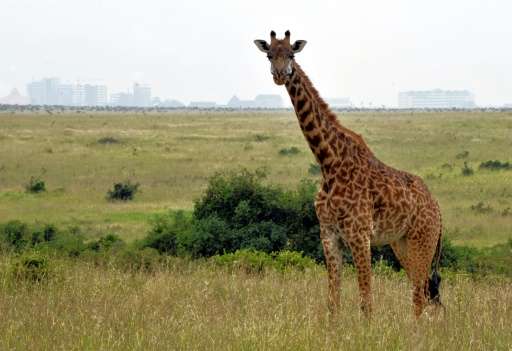Humans pose ever-bigger extinction risk to animals: review

An ever-expanding human population and exploding demand for food, water and living space, will place animals at "unprecedented" extinction risk in the next 50 years, experts warned Wednesday.
Facing the highest level of threat are more than 360 species of large mammals in Africa, Asia and South America—the most biodiverse regions of the world, said a review published in the journal Nature Insight.
But all is not lost, and a drastic change to human diets and farming methods could provide "healthy diets" for 10 billion people by 2060, while also preserving liveable habitats for most remaining species, it concluded.
"With forethought and timely action, these goals can be achieved."
Successive waves of species extinctions have followed in the wake of modern humans' spread out of Africa to the rest of the world.
By 3,000 years ago, Earth had lost half of its terrestrial mammal mega-species—animals which weigh more than 44 kilogrammes (97 pounds)—and 15 percent of its birds.
The human population at seven billion is now 25 times larger than it was then, and projected to add another four billion mouths to feed by century's end.
Already, a quarter of mammal species and 13 percent of birds are threatened with extinction, said the review authors.
"Extinction rates for birds, mammals and amphibians are similar at present to those of the five global mass-extinction events of the past 500 million years that probably resulted from meteorite impacts, massive volcanism and other cataclysmic forces," they wrote.
One such event is thought to have wiped out the dinosaurs.
Hunting, culling and poaching imperils up to half of threatened bird and mammal species, said the paper.
Farm better, eat better
Designated protected areas now cover about 14 percent of Earth's land surface, yet biodiversity continues to decline worldwide.
In parts of Africa, for example, lion populations have fallen to 10 percent of their potential largely due to human encroachment.
Between 1970 and 1998, bushmeat consumption in Ghana led to a near 80-percent population decline in 41 mammal species.
Threats to animal survival increase in step with a rise in human population and disposable income.
Globally, a further 710 million hectares would need to be cleared to meet the projected demand for food by 2060. Of the total, 430 million hectares—almost half the size of the United States—would be in sub-Saharan Africa.
Safeguarding Earth's precious creatures amid such pressures will require the expansion and better management of conservation areas, the authors argued.
"The ultimate drivers of hunting and poaching must be addressed, for example, by providing people with alternative livelihoods or sources of protein."
Also, agricultural yields—the crop produced per available hectare of land—must be increased through measures that include protecting soil fertility, and using more pest- and drought-resistant seeds.
Modifying diets can play a crucial role, said the review.
The more money a society has, the more it tends to splurge on meat and other animal products, sugar and starch—all commodities that require a lot of land and water to grow.
The authors advise eating more fruit and vegetables, nuts and seeds.
More information: David Tilman et al. Future threats to biodiversity and pathways to their prevention, Nature (2017). DOI: 10.1038/nature22900 , www.nature.com/nature/journal/ … ull/nature22900.html
Journal information: Nature
© 2017 AFP




















